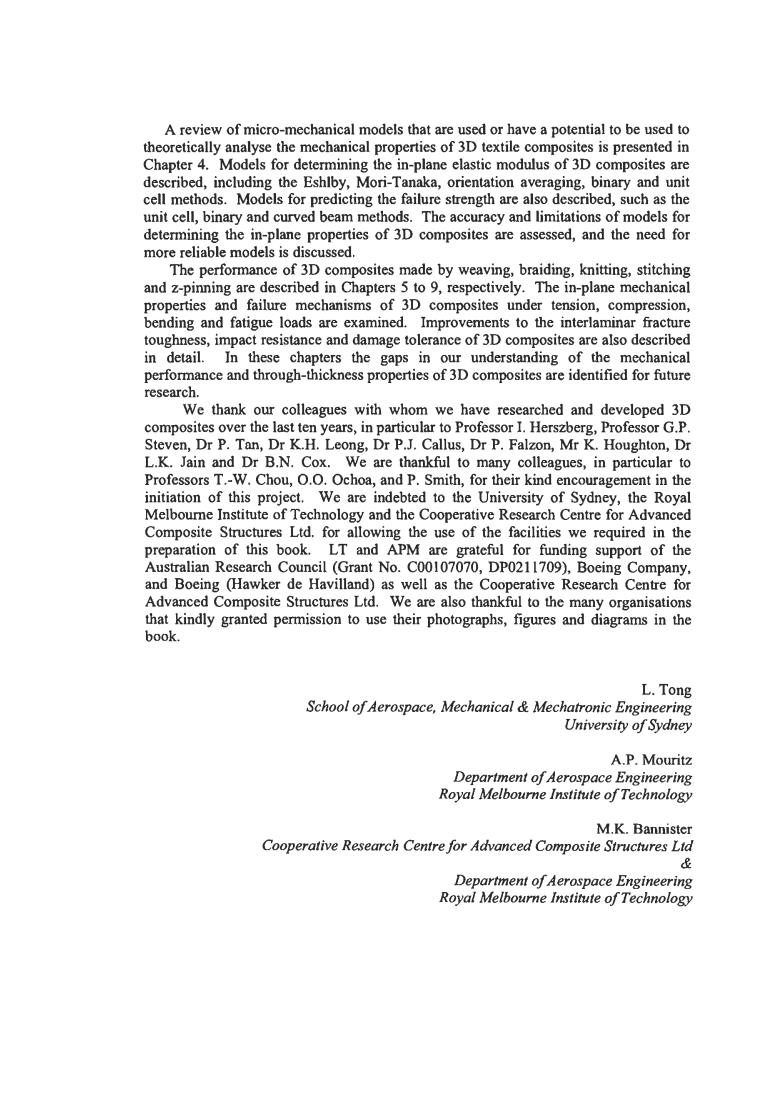正在加载图片...

A review of micro-mechanical models that are used or have a potential to be used to theoretically analyse the mechanical properties of 3D textile composites is presented in Chapter 4.Models for determining the in-plane elastic modulus of 3D composites are described,including the Eshlby,Mori-Tanaka,orientation averaging,binary and unit cell methods.Models for predicting the failure strength are also described,such as the unit cell,binary and curved beam methods.The accuracy and limitations of models for determining the in-plane properties of 3D composites are assessed,and the need for more reliable models is discussed. The performance of 3D composites made by weaving,braiding,knitting,stitching and z-pinning are described in Chapters 5 to 9,respectively.The in-plane mechanical properties and failure mechanisms of 3D composites under tension,compression, bending and fatigue loads are examined.Improvements to the interlaminar fracture toughness,impact resistance and damage tolerance of 3D composites are also described in detail.In these chapters the gaps in our understanding of the mechanical performance and through-thickness properties of 3D composites are identified for future research. We thank our colleagues with whom we have researched and developed 3D composites over the last ten years,in particular to Professor I.Herszberg,Professor G.P. Steven,Dr P.Tan,Dr K.H.Leong,Dr P.J.Callus,Dr P.Falzon,Mr K.Houghton,Dr L.K.Jain and Dr B.N.Cox.We are thankful to many colleagues,in particular to Professors T.-W.Chou,O.O.Ochoa,and P.Smith,for their kind encouragement in the initiation of this project.We are indebted to the University of Sydney,the Royal Melbourne Institute of Technology and the Cooperative Research Centre for Advanced Composite Structures Ltd.for allowing the use of the facilities we required in the preparation of this book.LT and APM are grateful for funding support of the Australian Research Council (Grant No.C00107070,DP0211709),Boeing Company, and Boeing (Hawker de Havilland)as well as the Cooperative Research Centre for Advanced Composite Structures Ltd.We are also thankful to the many organisations that kindly granted permission to use their photographs,figures and diagrams in the b00k. L.Tong School of Aerospace,Mechanical Mechatronic Engineering University of Sydney A.P.Mouritz Department of Aerospace Engineering Royal Melbourne Institute of Technology M.K.Bannister Cooperative Research Centre for Advanced Composite Structures Ltd & Department of Aerospace Engineering Royal Melbourne Institute of TechnologyA review of micro-mechanical models that are used or have a potential to be used to theoretically analyse the mechanical properties of 3D textile composites is presented in Chapter 4. Models for determining the in-plane elastic modulus of 3D composites are described, including the Eshlby, Mori-Tanaka, orientation averaging, binary and unit cell methods. Models for predicting the failure strength are also described, such as the unit cell, binary and curved beam methods. The accuracy and limitations of models for determining the in-plane properties of 3D composites are assessed, and the need for more reliable models is discussed. The performance of 3D composites made by weaving, braiding, knitting, stitching and z-pinning are described in Chapters 5 to 9, respectively. The in-plane mechanical properties and failure mechanisms of 3D composites under tension, compression, bending and fatigue loads are examined Improvements to the interlaminar fkacture toughness, impact resistance and damage tolerance of 3D composites are also described in detail. In these chapters the gaps in our understanding of the mechanical performance and through-thickness properties of 3D composites are identified for future research. We thank our colleagues with whom we have researched and developed 3D composites over the last ten years, in particular to Professor I. Herszberg, Professor G.P. Steven, Dr P. Tan, Dr K.H. Leong, Dr P.J. Callus, Dr P. Falzon, Mr K. Houghton, Dr L.K. Jain and Dr B.N. Cox. We are thankful to many colleagues, in particular to Professors T.-W. Chou, 0.0. Ochoa, and P. Smith, for their kind encouragement in the initiation of this project. We are indebted to the University of Sydney, the Royal Melbourne Institute of Technology and the Cooperative Research Centre for Advanced Composite Structures Ltd. for allowing the use of the facilities we required in the preparation of this book. LT and APM are grateful for funding support of the Australian Research Council (Grant No. C00107070, DP0211709), Boeing Company, and Boeing (Hawker de Havilland) as well as the Cooperative Research Centre for Advanced Composite Structures Ltd. We are also thankful to the many organisations that kindly granted permission to use their photographs, figures and diagrams in the book. L. Tong School of Aerospace, Mechanical & Mechatronic Engineering University of Sydney A.P. Mouritz Department of Aerospace Engineering Royal Melbourne Institute of Technology M.K. Bannister Cooperative Research Centre for Advanced Composite Structures Ltd & Department of Aerospace Engineering Royal Melbourne Institute of Technologv